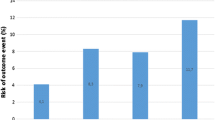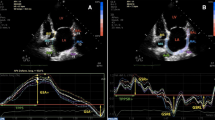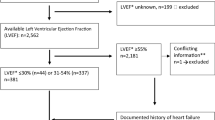Abstract
Previous studies have focused on only 1 or 2 echocardiographic parameters as prognostic markers in patients with acute ischemic stroke (AIS). A total of 900 patients with AIS who underwent transthoracic echocardiography (72.6 ± 12.0 years and 60% males) were retrospectively reviewed. Composite clinical events, including all-cause mortality, non-fatal stroke, non-fatal myocardial infarction, and coronary revascularization, were assessed during clinical follow-ups. During a median follow-up of 3.3 years (interquartile range 0.6–5.1 years), there were 151 (16.8%) composite events. In the multivariable analyses after controlling for potential confounders, left ventricular ejection fraction (LVEF) < 62% (hazard ratio [HR] 1.62; 95% confidence interval [CI] 1.14–2.30; p = 0.007) and AV sclerosis (AVs) (HR 1.56; 95% CI 1.10–2.21; p = 0.013) were independent prognostic factors associated with composite events. Multivariable analyses showed that HR for composite events gradually increased according to LVEF and AVs: HR was 2.6-fold higher in the highest-risk group than in the lowest group (p < 0.001). Compared with a clinical model (global chi-square = 69.6), LVEF, AVs, and both of them were significantly improved outcome prediction in sequential Cox model analysis (global chi-square = 75.6, 75.7, and 78.8, respectively; p < 0.05 for each) for each. In patients with AIS, LVEF < 62%, and the presence of AV sclerosis can predict future vascular events. Patients with AIS exhibiting reduced LVEF and AV sclerosis may benefit from aggressive secondary prevention.




Similar content being viewed by others
References
Hong KS, Bang OY, Kang DW et al (2013) Stroke statistics in Korea: part I. Epidemiology and risk factors: a report from the Korean Stroke Society and Clinical Research Center For stroke. J Stroke 15(1):2–20. https://doi.org/10.5853/jos.2013.15.1.2
Chen Z, Venkat P, Seyfried D et al (2017) Brain–heart interaction: cardiac complications after stroke. Circ Res 121(4):451–468. https://doi.org/10.1161/circresaha.117.311170
Samuels MA (2007) The brain-heart connection. Circulation 116(1):77–84. https://doi.org/10.1161/circulationaha.106.678995
Burkot J, Kopec G, Pera J et al (2015) Decompensated heart failure is a strong independent predictor of functional outcome after ischemic stroke. J Card Fail 21(8):642–646. https://doi.org/10.1016/j.cardfail.2015.03.008
Divani AA, Vazquez G, Asadollahi M et al (2009) Nationwide frequency and association of heart failure on stroke outcomes in the United States. J Card Fail 15(1):11–16. https://doi.org/10.1016/j.cardfail.2008.09.001
Milionis H, Faouzi M, Cordier M et al (2013) Characteristics and early and long-term outcome in patients with acute ischemic stroke and low ejection fraction. Int J Cardiol 168(2):1082–1087. https://doi.org/10.1016/j.ijcard.2012.11.036
Ois A, Cuadrado-Godia E, Jimenez-Conde J et al (2007) Early arterial study in the prediction of mortality after acute ischemic stroke. Stroke 38(7):2085–2089. https://doi.org/10.1161/strokeaha.107.482950
Petty GW, Brown RD Jr, Whisnant JP et al (2000) Ischemic stroke subtypes : a population-based study of functional outcome, survival, and recurrence. Stroke 31(5):1062–1068
Putaala J, Curtze S, Hiltunen S et al (2009) Causes of death and predictors of 5-year mortality in young adults after first-ever ischemic stroke: the Helsinki Young Stroke Registry. Stroke 40(8):2698–2703. https://doi.org/10.1161/strokeaha.109.554998
Ryu WS, Park JB, Ko SB et al (2016) Diastolic dysfunction and outcome in acute ischemic stroke. Cerebrovasc Dis 41(3–4):148–155. https://doi.org/10.1159/000442006
Park HK, Kim BJ, Yoon CH et al (2016) Left ventricular diastolic dysfunction in ischemic stroke: functional and vascular outcomes. J Stroke 18(2):195–202. https://doi.org/10.5853/jos.2015.01697
Powers WJ, Rabinstein AA, Ackerson T et al (2018) 2018 Guidelines for the Early Management of Patients with Acute Ischemic Stroke: a guideline for Healthcare Professionals from the American Heart Association/American Stroke Association. Stroke 49(3):e46–e110. https://doi.org/10.1161/str.0000000000000158
Gillum RF, Fortmann SP, Prineas RJ et al (1984) International diagnostic criteria for acute myocardial infarction and acute stroke. Am Heart J 108(1):150–158
Brott T, Adams HP Jr, Olinger CP et al (1989) Measurements of acute cerebral infarction: a clinical examination scale. Stroke 20(7):864–870
Lang RM, Badano LP, Mor-Avi V et al (2015) Recommendations for cardiac chamber quantification by echocardiography in adults: an update from the American Society of Echocardiography and the European Association of Cardiovascular Imaging. Eur Heart J Cardiovasc Imaging 16(3):233–270. https://doi.org/10.1093/ehjci/jev014
Nagueh SF, Smiseth OA, Appleton CP et al (2016) Recommendations for the Evaluation of Left Ventricular Diastolic Function by Echocardiography: An Update from the American Society of Echocardiography and the European Association of Cardiovascular Imaging. Eur Heart J Cardiovasc Imaging 17(12):1321–1360. https://doi.org/10.1093/ehjci/jew082
Barasch E, Gottdiener JS, Larsen EK et al (2006) Clinical significance of calcification of the fibrous skeleton of the heart and aortosclerosis in community dwelling elderly The Cardiovascular Health Study (CHS). Am Heart J 151(1):39–47. https://doi.org/10.1016/j.ahj.2005.03.052
Ishizuka K, Hoshino T, Ashihara K et al (2018) Associations of mitral and aortic valve calcifications with complex aortic atheroma in patients with embolic stroke of undetermined source. J Stroke Cerebrovasc Dis 27(3):697–702. https://doi.org/10.1016/j.jstrokecerebrovasdis.2017.09.057
Hankey GJ, Jamrozik K, Broadhurst RJ et al (1998) Long-term risk of first recurrent stroke in the Perth Community Stroke Study. Stroke 29(12):2491–2500
Thygesen K, Alpert JS, Jaffe AS et al (2018) Fourth universal definition of myocardial infarction (2018). Eur Heart J 40(3):237–269. https://doi.org/10.1093/eurheartj/ehy462
Yin J, Tian L (2014) Joint confidence region estimation for area under ROC curve and Youden index. Stat Med 33(6):985–1000. https://doi.org/10.1002/sim.5992
Kim WJ, Nah HW, Kim DH et al (2016) Association between left ventricular dysfunction and functional outcomes at three months in acute ischemic stroke. J Stroke Cerebrovasc Dis 25(9):2247–2252. https://doi.org/10.1016/j.jstrokecerebrovasdis.2016.05.004
Cuadrado-Godia E, Ois A, Roquer J (2010) Heart failure in acute ischemic stroke. Curr Cardiol Rev 6(3):202–213. https://doi.org/10.2174/157340310791658776
Wira CR 3rd, Rivers E, Martinez-Capolino C, Silver B, Iyer G, Sherwin R, Lewandowski C (2011) Cardiac complications in acute ischemic stroke. West J Emerg Med 12(4):414–420. https://doi.org/10.5811/westjem.2011.2.1765
Coffey S, Cox B, Williams MJ (2014) The prevalence, incidence, progression, and risks of aortic valve sclerosis: a systematic review and meta-analysis. J Am Coll Cardiol 63(25 Pt A):2852–2861. https://doi.org/10.1016/j.jacc.2014.04.018
Di Minno MND, Di Minno A, Ambrosino P et al (2018) Cardiovascular morbidity and mortality in patients with aortic valve sclerosis: a systematic review and meta-analysis. Int J Cardiol 260:138–144. https://doi.org/10.1016/j.ijcard.2018.01.054
Owens DS, Budoff MJ, Katz R et al (2012) Aortic valve calcium independently predicts coronary and cardiovascular events in a primary prevention population. JACC Cardiovasc Imaging 5(6):619–625. https://doi.org/10.1016/j.jcmg.2011.12.023
Rajamani K, Chaturvedi S, Jin Z et al (2009) Patent foramen ovale, cardiac valve thickening, and antiphospholipid antibodies as risk factors for subsequent vascular events: the PICSS-APASS study. Stroke 40(7):2337–2342. https://doi.org/10.1161/STROKEAHA.108.539171
Kohsaka S, Jin Z, Rundek T, Boden-Albala B et al (2008) Impact of mitral annular calcification on cardiovascular events in a multiethnic community: the Northern Manhattan Study. JACC Cardiovasc Imaging 1(5):617–623. https://doi.org/10.1016/j.jcmg.2008.07.006
Allison MA, Cheung P, Criqui MH et al (2006) Mitral and aortic annular calcification are highly associated with systemic calcified atherosclerosis. Circulation 113(6):861–866. https://doi.org/10.1161/CIRCULATIONAHA.105.552844
Fox CS, Vasan RS, Parise H et al (2003) Mitral annular calcification predicts cardiovascular morbidity and mortality: the Framingham Heart Study. Circulation 107(11):1492–1496
Tenenbaum A, Shemesh J, Fisman EZ et al (2000) Advanced mitral annular calcification is associated with severe coronary calcification on fast dual spiral computed tomography. Invest Radiol 35(3):193–198
O'Brien PJ, Thiemann DR, McNamara RL et al (1998) Usefulness of transesophageal echocardiography in predicting mortality and morbidity in stroke patients without clinically known cardiac sources of embolus. Am J Cardiol 81(9):1144–1151
Karas MG, Francescone S, Segal AZ et al (2007) Relation between mitral annular calcium and complex aortic atheroma in patients with cerebral ischemia referred for transesophageal echocardiography. Am J Cardiol 99(9):1306–1311. https://doi.org/10.1016/j.amjcard.2006.12.053
Hamon M, Gomes S, Oppenheim C et al (2006) Cerebral microembolism during cardiac catheterization and risk of acute brain injury: a prospective diffusion-weighted magnetic resonance imaging study. Stroke 37(8):2035–2038. https://doi.org/10.1161/01.str.0000231641.55843.49
Willens HJ, Ferreira AC, Gallagher AJ et al (2003) Mobile components associated with rapidly developing mitral annulus calcification in patients with chronic renal failure: review of mobile elements associated with mitral annulus calcification. Echocardiography 20(4):363–367
Rancurel G, Marelle L, Vincent D et al (1989) Spontaneous calcific cerebral embolus from a calcific aortic stenosis in a middle cerebral artery infarct. Stroke 20(5):691–693
Stein PD, Sabbah HN, Pitha JV (1977) Continuing disease process of calcific aortic stenosis. Role of microthrombi and turbulent flow. Am J Cardiol 39(2):159–163
Saric M, Armour AC, Arnaout MS et al (2016) Guidelines for the use of echocardiography in the evaluation of a cardiac source of embolism. J Am Soc Echocardiogr 29(1):1–42. https://doi.org/10.1016/j.echo.2015.09.011
Author information
Authors and Affiliations
Corresponding author
Ethics declarations
Conflict of interest
All authors declare that they have no conflict of interest.
Ethical approval
All procedures performed in studies involving human participants were in accordance with the ethical standards of the institutional research committee and with 1964 Helsinki Declaration and its later amendments or comparable ethical standards.
Informed consent
The study was approved by the Institutional Review Board with a waiver of consent.
Additional information
Publisher's Note
Springer Nature remains neutral with regard to jurisdictional claims in published maps and institutional affiliations.
Electronic supplementary material
Below is the link to the electronic supplementary material.
Rights and permissions
About this article
Cite this article
Kim, M., Kim, HL., Park, KT. et al. Echocardiographic parameters determining cardiovascular outcomes in patients after acute ischemic stroke. Int J Cardiovasc Imaging 36, 1445–1454 (2020). https://doi.org/10.1007/s10554-020-01841-5
Received:
Accepted:
Published:
Issue Date:
DOI: https://doi.org/10.1007/s10554-020-01841-5




